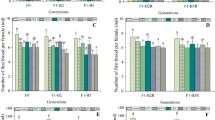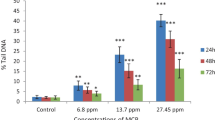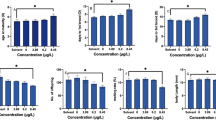Abstract
The non-steroidal anti-inflammatory drug (NSAID) diclofenac is one of the most frequently studied as well as controversially discussed pharmaceutically active drug on the subject of its relevance to the environment. This study was conducted to assess the bioconcentration potential of diclofenac and its behavioral and biochemical effects in Daphnia magna. The bioconcentration factors of diclofenac determined after 48 h of aqueous exposure in Daphnia magna were 70.94 and 8.02 for the nominal exposure concentrations of 5 and 100 μg/L, respectively. Diclofenac exposure obviously decreased the filtration and ingestion rates of the daphnids. A significant increase of the acetylcholinesterase activity that was observed in this study indicates that diclofenac might not have neurobehavioral toxicity in Daphnia magna. Significant induction of malondialdehyde content is an indication of overproduction of reactive oxygen species leading to oxidative damage in daphnids after diclofenac exposure. Moreover, significant inhibition of the superoxide dismutase, catalase, and glutathione reductase activities implies that the antioxidant defense system of Daphnia magna was overwhelmed. Also, significant inhibition of glutathione s-transferase activity might point to the fact that the enzyme was not capable to detoxify diclofenac in Daphnia magna. These findings indicate that diclofenac can accumulate and consequently stimulate behavioral and biochemical disturbances in Daphnia magna.





Similar content being viewed by others
References
Adam L, Katherine L, Erik TK (2011) Bioconcentration of the intense sweetener sucralose in a multitrophic battery of aquatic organisms. Environ Toxicol Chem 30:673–681
Arnot JA, Gobas FAPC (2006) A review of bioconcentration factor (BCF) and bioaccumulation factor (BAF) assessments for organic chemicals in aquatic organisms. Environ Rev 14:257–297
Barata C, Varo I, Navarro JC, Arun S, Porte C (2005) Antioxidant enzyme activities and lipid peroxidation in the freshwater cladoceran Daphnia magna exposed to redox cycling compounds. Comp Biochem Physiol C Toxicol Pharmacol 140:175–186
Barnes KK, Kolpin DW, Furlong ET, Zaugg SD, Meyer MT, Barber LB (2008) A national reconnaissance of pharmaceuticals and other organic wastewater contaminants in the United States — I) groundwater. Sci Total Environ 402:192–200
Bickley LK, van Aerle R, Brown AR, Hargreaves A, Huby R, Cammack V, Jackson R, Santos EM, Tyler CR (2017) Bioavailability and kidney responses to diclofenac in the fathead minnow (Pimephales promelas). Environ Sci Technol 51:1764–1774
Bradford MM (1976) A rapid and sensitive method for the quantitation of microgram quantities of protein utilizing the principle of protein-dye binding. Anal Biochem 72:248–254
Brown JN, Paxéus N, Förlin L, Larsson DJ (2007) Variations in bioconcentration of human pharmaceuticals from sewage effluents into fish blood plasma. Environ Toxicol Pharmacol 24:267–274
Buser H-R, Poiger T, Müller MD (1998) Occurrence and fate of the pharmaceutical drug diclofenac in surface waters: rapid photodegradation in a Lake. Environ Sci Technol 32:3449–3456
Cleuvers M (2003) Aquatic ecotoxicity of pharmaceuticals including the assessment of combination effects. Toxicol Lett 142:185–194
Contardo-Jara V, Lorenz C, Pflugmacher S, Nützmann G, Kloas W, Wiegand C (2011) Exposure to human pharmaceuticals carbamazepine, ibuprofen and Bezafibrate causes molecular effects in Dreissena polymorpha. Aquat Toxicol 105:428–437
Cunningham VL (2004) Special characteristics of pharmaceuticals related to environmental fate. In: Kümmerer K (ed) Pharmaceuticals in the environment: sources, fate, effects and risks. Springer Berlin Heidelberg, Berlin, pp 13–24
Ding J, Lu G, Liu J, Yang H, Li Y (2016) Uptake, depuration, and bioconcentration of two pharmaceuticals, roxithromycin and propranolol, in Daphnia magna. Ecotoxicol Environ Saf 126:85–93
Ding J, Zou H, Liu Q, Zhang S, Mamitiana Razanajatovo R (2017) Bioconcentration of the antidepressant fluoxetine and its effects on the physiological and biochemical status in Daphnia magna. Ecotoxicol Environ Saf 142:102–109
EU (2013) Directive 2013/39/EU of the European Parliament and of the council of 12 August 2013 amending directives 2000/60/EC and 2008/105/EC as regards priority substances in the field of water policy European Union off. J Eur Union L226
Ferrari B, Paxéus N, Giudice RL, Pollio A, Garric J (2003) Ecotoxicological impact of pharmaceuticals found in treated wastewaters: study of carbamazepine, clofibric acid, and diclofenac. Ecotoxicol Environ Saf 55:359–370
Ferrari B, Mons R, Vollat B, Fraysse B, Paxēaus N, Giudice RL, Pollio A, Garric J (2004) Environmental risk assessment of six human pharmaceuticals: are the current environmental risk assessment procedures sufficient for the protection of the aquatic environment? Environ Toxicol Chem 23:1344–1354
Filip C, Erik K, Jerker F, Noomi A, Lars F, Joakim LDG (2011) Diclofenac in fish: blood plasma levels similar to human therapeutic levels affect global hepatic gene expression. Environ Toxicol Chem 30:2126–2134
Gan TJ (2010) Diclofenac: an update on its mechanism of action and safety profile. Curr Med Res Opin 26:1715–1731
Gauld DT (1951) The grazing rate of planktonic copepods. J Mar Biol Assoc U K 29:695–706
Gonzalez-Rey M, Bebianno MJ (2012) Does non-steroidal anti-inflammatory (NSAID) ibuprofen induce antioxidant stress and endocrine disruption in mussel Mytilus galloprovincialis? Environ Toxicol Pharmacol 33:361–371
Gonzalez-Rey M, Bebianno MJ (2014) Effects of non-steroidal anti-inflammatory drug (NSAID) diclofenac exposure in mussel Mytilus galloprovincialis. Aquat Toxicol 148:221–230
Halling-Sørensen B, Nors Nielsen S, Lanzky PF, Ingerslev F, Holten Lützhøft HC, Jørgensen SE (1998) Occurrence, fate and effects of pharmaceutical substances in the environment- a review. Chemosphere 36:357–393
Heberer T, Mechlinski A, Fanck B, Knappe A, Massmann G, Pekdeger A, Fritz B (2004) Field studies on the fate and transport of pharmaceutical residues in bank filtration. Ground Water Monit Remed 24:70–77
Holland (2018) EGU2018: New global models predict increasing pollution of rivers. https://www.dutchwatersector.com/news-events/news/30914-egu2018-new-global-models-predict-increasing-pollution-of-rivers.html. Accessed 21/10/2018
Islas-Flores H, Gómez-Oliván LM, Galar-Martínez M, Colín-Cruz A, Neri-Cruz N, García-Medina S (2013) Diclofenac-induced oxidative stress in brain, liver, gill and blood of common carp (Cyprinus carpio). Ecotoxicol Environ Saf 92:32–38
Jeong TY, Kim TH, Kim SD (2016) Bioaccumulation and biotransformation of the beta-blocker propranolol in multigenerational exposure to Daphnia magna. Environ Pollut 216:811–818
Jux U, Baginski RM, Arnold H-G, Krönke M, Seng PN (2002) Detection of pharmaceutical contaminations of river, pond, and tap water from Cologne (Germany) and surroundings. Int J Hyg Environ Health 205:393–398
Kallio J-M, Lahti M, Oikari A, Kronberg L (2010) Metabolites of the aquatic pollutant diclofenac in fish bile. Environ Sci Technol 44:7213–7219
Kappus H (1985) Lipid peroxidation: mechanisms, analysis, enzymology and biological relevance. In: Sies H (ed) Oxidative stress. Academic, New York, pp 273–310
Kim HY, Jeon J, Hollender J, Yu S, Kim SD (2014) Aqueous and dietary bioaccumulation of antibiotic tetracycline in D. magna and its multigenerational transfer. J Hazard Mater 279:428–435
Li Z-H, Velisek J, Zlabek V, Grabic R, Machova J, Kolarova J, Randak T (2010) Hepatic antioxidant status and hematological parameters in rainbow trout, Oncorhynchus mykiss, after chronic exposure to carbamazepine. Chem Biol Interact 183:98–104
Liang R, He J, Shi Y, Li Z, Sarvajayakesavalu S, Baninla Y, Guo F, Chen J, Xu X, Lu Y (2017) Effects of perfluorooctane sulfonate on immobilization, heartbeat, reproductive and biochemical performance of Daphnia magna. Chemosphere 168:1613–1618
Liu J, Lu G, Ding J, Zhang Z, Wang Y (2014a) Tissue distribution, bioconcentration, metabolism, and effects of erythromycin in crucian carp (Carassius auratus). Sci Total Environ 490:914–920
Liu J, Lu G, Wang Y, Yan Z, Yang X, Ding J, Jiang Z (2014b) Bioconcentration, metabolism, and biomarker responses in freshwater fish Carassius auratus exposed to roxithromycin. Chemosphere 99:102–108
Liu J, Lu G, Yang H, Yan Z, Wang Y, Wang P (2016) Bioconcentration and metabolism of ketoconazole and effects on multi-biomarkers in crucian carp (Carassius auratus). Chemosphere 150:145–151
Liu J, Lu G, Cai Y, Wu D, Yan Z, Wang Y (2017) Modulation of erythromycin-induced biochemical responses in crucian carp by ketoconazole. Environ Sci Pollut Res 24:5285–5292
Liu Y, Guo R, Tang S, Zhu F, Zhang S, Yan Z, Chen J (2018) Single and mixture toxicities of BDE-47, 6-OH-BDE-47 and 6-MeO-BDE-47 on the feeding activity of Daphnia magna: from behavior assessment to neurotoxicity. Chemosphere 195:542–550
Lonappan L, Brar SK, Das RK, Verma M, Surampalli RY (2016) Diclofenac and its transformation products: environmental occurrence and toxicity - a review. Environ Int 96:127–138
Loos R, Gawlik BM, Locoro G, Rimaviciute E, Contini S, Bidoglio G (2009) EU-wide survey of polar organic persistent pollutants in European river waters. Environ Pollut 157:561–568
Ma J, Liu Y, Niu D, Li X (2015) Effects of chlorpyrifos on the transcription of CYP3A cDNA, activity of acetylcholinesterase, and oxidative stress response of goldfish (Carassius auratus). Environ Toxicol 30:422–429
Memmert U, Peither A, Burri R, Weber K, Schmidt T, Sumpter JP, Hartmann A (2013) Diclofenac: new data on chronic toxicity and bioconcentration in fish. Environ Toxicol Chem 32:442–452
Meredith-Williams M, Carter LJ, Fussell R, Raffaelli D, Ashauer R, Boxall ABA (2012) Uptake and depuration of pharmaceuticals in aquatic invertebrates. Environ Pollut 165:250–258
Milan M, Pauletto M, Patarnello T, Bargelloni L, Marin MG, Matozzo V (2013) Gene transcription and biomarker responses in the clam Ruditapes philippinarum after exposure to ibuprofen. Aquat Toxicol 126:17–29
Mwaanga P, Carraway ER, van den Hurk P (2014) The induction of biochemical changes in Daphnia magna by CuO and ZnO nanoparticles. Aquat Toxicol 150:201–209
Oliveira LL, Antunes SC, Gonçalves F, Rocha O, Nunes B (2015) Evaluation of ecotoxicological effects of drugs on Daphnia magna using different enzymatic biomarkers. Ecotoxicol Environ Saf 119:123–131
Organization for Economic Cooperation and Development (OECD) (2004) Guidelines for testing of chemicals no. 202: Daphnia magna acute immobilization test. Paris
Pirow R, Wollinger F, Paul RJ (1999) The sites of respiratory gas exchange in the planktonic crustacean Daphnia magna: an in vivo study employing blood haemoglobin as an internal oxygen probe. J Exp Biol 202:3089–3099
Pohanka M (2011) Cholinesterases, a target of pharmacology and toxicology. Biomed Pap Med Fac Palacky Olomouc Czech Repub 155:219–229
Pohanka M (2012) Acetylcholinesterase inhibitors: a patent review (2008–present). Expert Opin Ther Pat 22:871–886
Porter K, Orcutt J Jr, Gerritsen J (1983) Functional response and fitness in a generalist filter feeder, Daphnia magna (Cladocera: Crustacea). Ecology 64:735–742
Saravanan M, Karthika S, Malarvizhi A, Ramesh M (2011) Ecotoxicological impacts of clofibric acid and diclofenac in common carp (Cyprinus carpio) fingerlings: hematological, biochemical, ionoregulatory and enzymological responses. J Hazard Mater 195:188–194
Schwaiger J, Ferling H, Mallow U, Wintermayr H, Negele RD (2004) Toxic effects of the non-steroidal anti-inflammatory drug diclofenac: part I: histopathological alterations and bioaccumulation in rainbow trout. Aquat Toxicol 68:141–150
Teijon G, Candela L, Tamoh K, Molina-Díaz A, Fernández-Alba A (2010) Occurrence of emerging contaminants, priority substances (2008/105/CE) and heavy metals in treated wastewater and groundwater at Depurbaix facility (Barcelona, Spain). Sci Total Environ 408:3584–3595
Ternes TA (1998) Occurrence of drugs in German sewage treatment plants and rivers. Water Res 32:3245–3260
Triebskorn R, Schwarz S, Köhler H, Berg K, Jungmann D, Frey M, Oehlmann J, Oetken M (2014) From theory to reality - evaluation of suitable organisms and test systems for the biomonitoring of pharmaceuticals - part I: literature review. UBA Texte, Umweltbundesamt, Dessau-Rosslau
USEPA (2007) Method 1694: pharmaceuticals and personal care products in water, soil, sediment, and biosolids by HPLC/MS/MS Washington, DC EPA-821-R-08-002:1-77
Van der Oost R, Beyer J, Vermeulen NP (2003) Fish bioaccumulation and biomarkers in environmental risk assessment: a review. Environ Toxicolo Pharmacol 13:57–149
Yonar ME, Yonar SM, Ural MŞ, Silici S, Düşükcan M (2012) Protective role of propolis in chlorpyrifos-induced changes in the haematological parameters and the oxidative/antioxidative status of Cyprinus carpio carpio. Food Chem Toxicol 50:2703–2708
Zaltauskaite J, Miskelyte D (2018) Biochemical and life cycle effects of triclosan chronic toxicity to earthworm Eisenia fetida. Environ Sci Pollut Res:1–9
Zhang X, Yang L, Zhao Q, Caen J, He H, Jin Q, Guo L, Alemany M, Zhang L, Shi Y (2002) Induction of acetylcholinesterase expression during apoptosis in various cell types. Cell Death Differ 9:790–800
Zhao H, Liu S, Chen J, Jiang J, Xie Q, Quan X (2015) Biological uptake and depuration of sulfadiazine and sulfamethoxazole in common carp (Cyprinus carpio). Chemosphere 120:592–597
Zhao J-L, Furlong ET, Schoenfuss HL, Kolpin DW, Bird KL, Feifarek DJ, Schwab EA, Ying G-G (2017) Uptake and disposition of select pharmaceuticals by bluegill exposed at constant concentrations in a flow-through aquatic exposure system. Environ Sci Technol 51:4434–4444
Zhu X, Chang Y, Chen Y (2010) Toxicity and bioaccumulation of TiO2 nanoparticle aggregates in Daphnia magna. Chemosphere 78:209–215
Funding
This study was supported by the National Natural Science Foundation of China (Grant 51769034, 51609066), the Fundamental Research Funds for the Central Universities (Grant 2018B43614), the Program for Scientific Research Innovation Team in Colleges and Universities of Tibet Autonomous Region, and the Priority Academic Program Development of Jiangsu Higher Education Institutions.
Author information
Authors and Affiliations
Corresponding author
Additional information
Responsible editor: Cinta Porte
Publisher’s Note
Springer Nature remains neutral with regard to jurisdictional claims in published maps and institutional affiliations.
Electronic supplementary material
ESM 1
(DOCX 35 kb)
Rights and permissions
About this article
Cite this article
Nkoom, M., Lu, G., Liu, J. et al. Bioconcentration, behavioral, and biochemical effects of the non-steroidal anti-inflammatory drug diclofenac in Daphnia magna. Environ Sci Pollut Res 26, 5704–5712 (2019). https://doi.org/10.1007/s11356-018-04072-3
Received:
Accepted:
Published:
Issue Date:
DOI: https://doi.org/10.1007/s11356-018-04072-3




